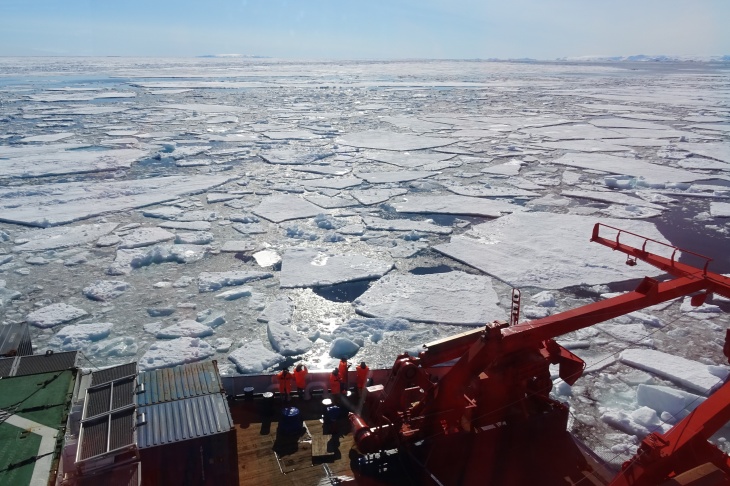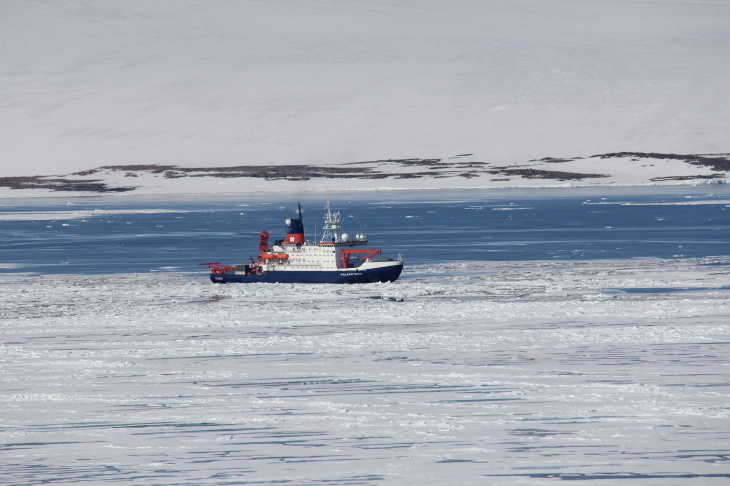New Organic Pollutant Detected in the Arctic Ocean for the First Time
Per- and polyfluoroalkyl substances (PFAS) can be found almost everywhere: in pizza boxes, in outdoor jackets, and in Teflon pans. These water-repellent chemicals, also used in industry, accumulate in the environment and in organisms and can lead to health problems. In a study that is now published in the journal ACS Environmental Science & Technology, scientist Hanna Joerss from the Helmholtz-Zentrum Geesthacht (HZG), together with an international team of scientists, examined the transport of 29 PFAS to and from the Arctic Ocean. In the process, they detected the recent compound HFPO-DA (trade name GenX) in the Arctic waters for the first time. Even substances that are now banned are likely to return to the oceans with the melting ice.

The gateway to the Arctic: Fram Strait, a remote sea area between Greenland and Svalbard. [Photo: HZG/Hanna Joerss]
Some PFAS, including PFOA (perfluorooctanoic acid) and PFOS (perfluorooctane sulfonic acid), are suspected of causing a reduced immune response to vaccinations. They can also cause high cholesterol and other health problems. Because of their worrying properties, the industry voluntarily withdrew PFOA and PFOS from the market, and the EU Commission severely restricted the use of PFOS in 2006.
HZG coastal researcher Hanna Joerss explains: “Because the pollutants are persistent and almost indestructible, they can still be found in large quantities in the environment.” The new substance, HFPO-DA (trade name GenX), is used in industry as a substitute for the regulated PFOA. This substance could also turn out to be dangerous for the marine environment, for animals living in the sea, and for human health.
In search of problem substances
![Hanna Joerss during the expedition on board the FS POLARSTERN. [Photo: HZG/Zhiyong Xie] Hanna Joerss an der REling im Hintergrund blauer Ozean](/imperia/md/images/hzg/presse/pressemitteilungen/2020/fittosize_730_0_d98140b08e67c27570a419e385ccb231_hanna_joerrs_on_board_polarstern.jpg)
Hanna Joerss during the expedition on board the FS POLARSTERN. [Photo: HZG/Zhiyong Xie]
Hanna Joerss and other researchers from the HZG, the University of Harvard, and the Alfred Wegener Institute (AWI) have investigated the long-range transport of PFAS waste and PFAS substitutes at the gateway to the Arctic, the Fram Strait, a remote sea area between Greenland and Spitsbergen.
![The route of the Polarstern through the Fram Strait. [Image: Alfred Wegener Institute] Map with the route through Fraim Strait](/imperia/md/images/hzg/presse/publications/in2science/fittosize__730_0_fbabc00ae068916972cfdf0d93e46451_fahrtroute_ps114.jpg)
The route of the Polarstern through the Fram Strait. [Image: Alfred Wegener Institute]
On board the research icebreaker RV POLARSTERN, they collected water samples along two currents that enter and exit the Arctic Ocean, as well as along the voyage from Bremerhaven to the Arctic and back to Tromsø (Norway). Sampling was carried out down to a depth of 3,000 meters.
With the help of mass spectrometry, the teams of scientists detected 11 different PFAS in the water samples, among them PFOA, PFOS, HFPO-DA and other long- and short-chain PFAS. This was the first time that the new chemical substitute HFPO-DA was detected in the seawater of such a remote region. The results show that the compound, like its predecessor substance, is transported over long distances.

With this water sampler the water is collected in different water depths. [Photo: HZG/Hanna Joerss]
Furthermore, higher concentrations of PFAS were found in seawater that leaves the Arctic Ocean than in water that enters the Arctic from the North Atlantic.
The characteristic composition of the various PFAS in the outgoing water indicates that a larger proportion comes from atmospheric sources than the incoming water in which transport by the ocean currents plays a greater role.
Climate change – a boomerang for pollutants

The research icebreaker FS POLARSTERN in the Arctic Ocean. [Photo: HZG/Zhiyong Xie]
That is why Hanna Joerrs is drawing attention to a problem: “Because of climate change and rising temperatures, the Arctic ice is melting. Pollutants that reached the Arctic over long distances and have been accumulating there for decades are now being released again.”
In this way, the Arctic ocean is becoming a source of pollutants, like PFOS, that have long been banned.
Original publication
Transport of Legacy Perfluoroalkyl Substances and the Replacement Compound HFPO−DA through the Atlantic Gateway to the Arctic Ocean – Is the Arctic a Sink or a Source?
Contact

Helmholtz-Zentrum Geesthacht
